Best Animals from the Hell Creek Formation
The Hell Creek Formation is a dig-site location located in Montana, North and South Dakota and Wyoming in the United States. The rocks found on Hell Creek date back to 66 million years during the end of the Cretaceous Period and is one of the most intensely studied and well-known dig sites in the world, with fauna such as Tyrannosaurus and Triceratops amongst the numerous fossil records found within the site.Aside from dinosaurs, there was a plentiful amount of animals found within the site, such as mammals, reptiles, birds and many others. Which creature from the site stood out the most for you?
To find more animals from the Hell Creek Formation, you can use good articles featuring fauna such as Wikipedia or you can research an upcoming (when this page was being made) dinosaur game "Saurian".
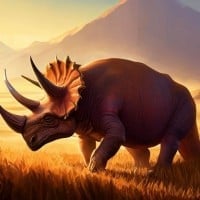 Triceratops is a genus of herbivorous ceratopsid dinosaur that first appeared during the late Maastrichtian stage of the late Cretaceous period, about 68 million years ago in what is now North America.
Triceratops is a genus of herbivorous ceratopsid dinosaur that first appeared during the late Maastrichtian stage of the late Cretaceous period, about 68 million years ago in what is now North America. A fan favorite for many, Triceratops remains are the most common in the formation. Alongside T. rex, a lot has been seen and learned from this dinosaur, such as living in herds and age and possibly sexual dimorphism.
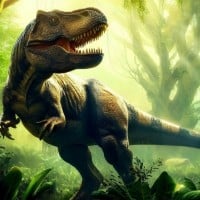 Tyrannosaurus, meaning "tyrant lizard", from the Ancient Greek tyrannos, "tyrant", and sauros, "lizard" is a genus of coelurosaurian theropod dinosaur. It also had a tremendous bite force, the strongest of any Dinosaur and living terrestrial animal. Its bite force reached up to 12,800 pounds (roughly... read more
Tyrannosaurus, meaning "tyrant lizard", from the Ancient Greek tyrannos, "tyrant", and sauros, "lizard" is a genus of coelurosaurian theropod dinosaur. It also had a tremendous bite force, the strongest of any Dinosaur and living terrestrial animal. Its bite force reached up to 12,800 pounds (roughly... read more Aside from being the most well-known dinosaur (and my all-time favorite animal), Tyrannosaurus remains and research from the Hell Creek have been significant. For example, the remains of Sue, the largest Tyrannosaurus remains discovered yet, were found there. There is also evidence of them living in groups and even engaging in cannibalism. Surprisingly, it is also the second most common dinosaur found in Hell Creek.
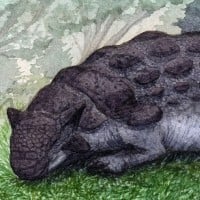 Ankylosaurus is a genus of armored dinosaur. Fossils of Ankylosaurus have been found in geological formations dating to the very end of the Cretaceous Period, between about 68–66 million years ago, in western North America, making it among the last of the non-avian dinosaurs.
Ankylosaurus is a genus of armored dinosaur. Fossils of Ankylosaurus have been found in geological formations dating to the very end of the Cretaceous Period, between about 68–66 million years ago, in western North America, making it among the last of the non-avian dinosaurs. My favorite plant-eating dinosaur, but the reason why Triceratops is higher is that not much has been found from Ankylosaurus. It looks badass and unique, that's for sure, but we have more evidence from Euplocephalus, an earlier ankylosaurid from millions of years earlier. I still love this dinosaur, though.
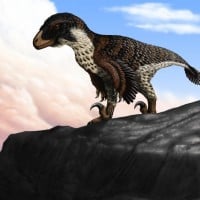 Dakotaraptor is a genus of large carnivorous theropod dromaeosaurid dinosaur from the Late Cretaceous of North America.
Dakotaraptor is a genus of large carnivorous theropod dromaeosaurid dinosaur from the Late Cretaceous of North America. I am so happy considering there is actually a decent-sized raptor in Hell Creek and it's even feathered to top it off. It could have provided competition against the juvenile and sub-adult T. rexes for food and territory.
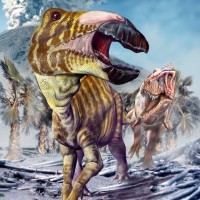 Edmontosaurus is a genus of hadrosaurid dinosaur. It contains two known species: Edmontosaurus regalis and Edmontosaurus annectens.
Edmontosaurus is a genus of hadrosaurid dinosaur. It contains two known species: Edmontosaurus regalis and Edmontosaurus annectens. I love hadrosaurs, and Edmontosaurus is definitely the poster boy when it comes to those without a crest. Despite not looking as imposing, it's still a pretty impressive dinosaur. One of the most well-preserved remains of a dinosaur was of an Edmontosaurus in Hell Creek. It was called the "Dinosaur Mummy" due to how well-preserved it was.
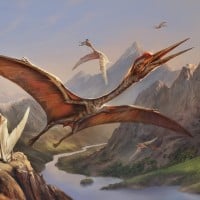 Quetzalcoatlus is a pterosaur known from the Late Cretaceous period of North America (Maastrichtian stage), it was one of the largest known flying animals of all time.
Quetzalcoatlus is a pterosaur known from the Late Cretaceous period of North America (Maastrichtian stage), it was one of the largest known flying animals of all time. Azhdarchidae remains have been found in Hell Creek. While they may not be of Quetzalcoatlus, the possibility of this pterosaur living in Hell Creek is quite likely as they would often come down to land to eat even small dinosaurs or remains of larger ones.
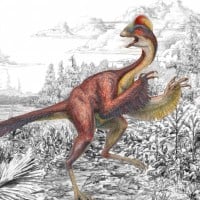 Anzu is a genus of large oviraptorosaurian dinosaurs from the late Cretaceous of North Dakota and South Dakota, US.
Anzu is a genus of large oviraptorosaurian dinosaurs from the late Cretaceous of North Dakota and South Dakota, US. A proper Oviraptorid in the Hell Creek makes me smile. It's surprising how much diversity the formation has. There may be a second, much larger one in the area, but the only evidence of such comes from footprints only.
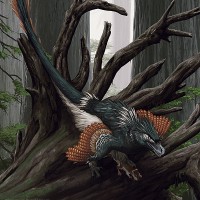
The first raptor to have enough fossil evidence to be formally classified in Hell Creek. Not as impressive as Dakotaraptor, but its discovery was important nonetheless.
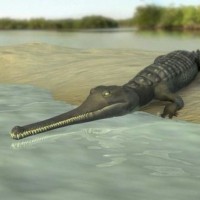 An extinct genus of crocodylian that lived during the Late Cretaceous to Early Paleogene periods, Thoracosaurus is known from fossil evidence found in North America and Europe. It was a long-snouted species adapted for piscivory, feeding mainly on fish.
An extinct genus of crocodylian that lived during the Late Cretaceous to Early Paleogene periods, Thoracosaurus is known from fossil evidence found in North America and Europe. It was a long-snouted species adapted for piscivory, feeding mainly on fish.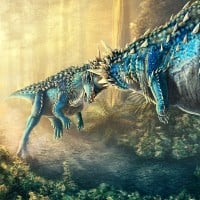
The most well-known bonehead. Despite this, the animal is actually quite rare to find in fact. However, Pachycephalosaurus itself is a popular dinosaur and its discovery is certainly important.
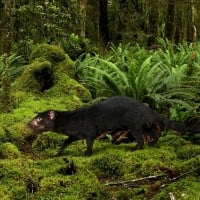
A marsupial mammal. Its survival is the reason why we have kangaroos and other living marsupials, so remember that.
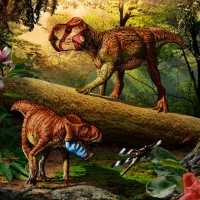 Leptoceratops, is a genus of primitive ceratopsian dinosaurs from the late Cretaceous Period of what is now Western North America.
Leptoceratops, is a genus of primitive ceratopsian dinosaurs from the late Cretaceous Period of what is now Western North America.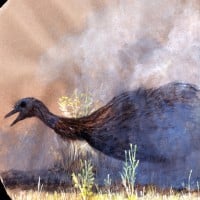 A genus of ornithomimid dinosaur that lived during the Late Cretaceous period, Struthiomimus resembled a large ostrich and is believed to have been omnivorous. It had long legs adapted for running and a beak-like mouth but lacked teeth. Fossil evidence suggests it inhabited what is now North America... read more
A genus of ornithomimid dinosaur that lived during the Late Cretaceous period, Struthiomimus resembled a large ostrich and is believed to have been omnivorous. It had long legs adapted for running and a beak-like mouth but lacked teeth. Fossil evidence suggests it inhabited what is now North America... read more An extinct reptile from the Late Cretaceous to Paleogene periods, Champsosaurus resembled modern-day crocodilians but was not closely related. Fossils have been found primarily in North America. It had a streamlined body adapted for an aquatic lifestyle, feeding primarily on fish.
An extinct reptile from the Late Cretaceous to Paleogene periods, Champsosaurus resembled modern-day crocodilians but was not closely related. Fossils have been found primarily in North America. It had a streamlined body adapted for an aquatic lifestyle, feeding primarily on fish. Thescelosaurus was a genus of small ornithopod dinosaur that appeared at the very end of the Late Cretaceous period in North America.
Thescelosaurus was a genus of small ornithopod dinosaur that appeared at the very end of the Late Cretaceous period in North America.